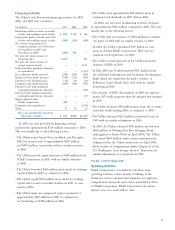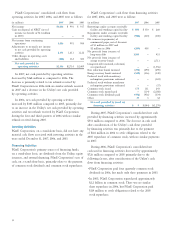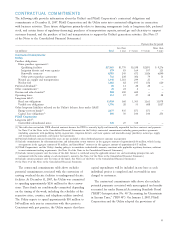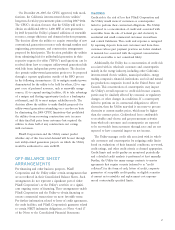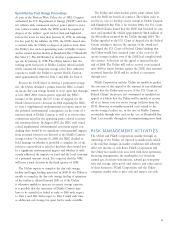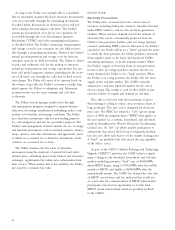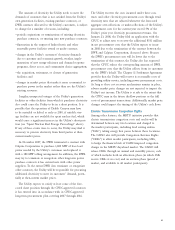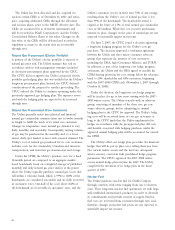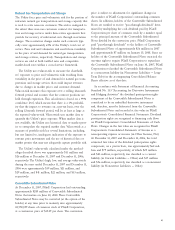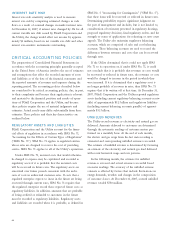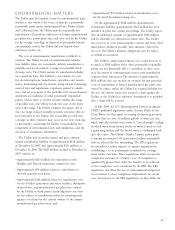PG&E 2007 Annual Report Download - page 62
Download and view the complete annual report
Please find page 62 of the 2007 PG&E annual report below. You can navigate through the pages in the report by either clicking on the pages listed below, or by using the keyword search tool below to find specific information within the annual report.60
As long as the Utility can conclude that it is probable
that its reasonably incurred wholesale electricity procurement
costs are recoverable through the ratemaking mechanism
described below, fl uctuations in electricity prices will not
affect earnings but may impact cash fl ows. The Utility’s
natural gas procurement costs for its core customers are
recoverable through the Core Procurement Incentive
Mechanism (“CPIM”) and other ratemaking mechanisms,
as described below. The Utility’s natural gas transportation
and storage costs for core customers are also fully recover-
able through a ratemaking mechanism. However, the Utility’s
natural gas transportation and storage costs for non-core
customers may not be fully recoverable. The Utility is subject
to price and volumetric risk for the portion of intrastate
natural gas transportation and storage capacity that has not
been sold under long-term contracts providing for the recov-
ery of all fi xed costs through the collection of fi xed reserva-
tion charges. The Utility sells most of its capacity based on
the volume of gas that the Utility’s customers actually ship,
which exposes the Utility to volumetric risk. Movement
in interest rates can also cause earnings and cash fl ow
to fl uctuate.
The Utility actively manages market risks through
risk management programs designed to support business
objectives, discourage unauthorized risk-taking, reduce com-
modity cost volatility, and manage cash fl ows. The Utility
uses derivative instruments only for non-trading purposes
(i.e., risk mitigation) and not for speculative purposes. The
Utility’s risk management activities include the use of energy
and fi nancial instruments, such as forward contracts, futures,
swaps, options, and other instruments and agreements, most
of which are accounted for as derivative instruments. Some
contracts are accounted for as leases.
The Utility estimates the fair value of derivative
instruments using the midpoint of quoted bid and asked
forward prices, including quotes from brokers and electronic
exchanges, supplemented by online price information from
news services. When market data is not available, the Utility
uses models to estimate fair value.
PRICE RISK
Electricity Procurement
The Utility relies on electricity from a diverse mix of
resources, including third-party contracts, amounts allocated
under DWR contracts, and its own electricity generation
facilities. When customer demand exceeds the amount of
electricity that can be economically produced from the
Utility’s own generation facilities plus net energy purchase
contracts (including DWR contracts allocated to the Utility’s
customers), the Utility will be in a “short” position. In order
to satisfy the short position, the Utility purchases electricity
from suppliers prior to the hour- and day-ahead CAISO
scheduling timeframes, or in the real-time market. When
the Utility’s supply of electricity from its own generation
resources plus net energy purchase contracts exceeds cus-
tomer demand, the Utility is in a “long” position. When
the Utility is in a long position, the Utility sells the excess
supply in the real-time market. The CAISO currently
administers a real-time wholesale market for the sale of
electric energy. This market is used by the CAISO to fi ne
tune the balance of supply and demand in real time.
Price risk is associated with the uncertainty of prices
when buying or selling to reduce open positions (short or
long positions). This price risk is mitigated by electricity
price caps. The FERC has adopted a “soft” cap on energy
prices of $400 per megawatt-hour (“MWh”) that applies to
the spot market (i.e., real-time, hour-ahead, and day-ahead
markets) throughout the Western Electricity Coordinating
Council area. (A “soft” cap allows market participants to
submit bids that exceed the bid cap if adequately justifi ed,
but does not allow such bids to set the market clearing price.
A “hard” cap prohibits bids that exceed the cap, regardless
of the seller’s costs.)
As part of the CAISO’s Market Redesign and Technology
Upgrade (“MRTU”) initiative, the CAISO plans to imple-
ment a change to the day-ahead, hour-ahead, and real-time
markets including new price “hard” caps of $500/MWh
when MRTU begins, rising to $750/MWh after the twelfth
month of MRTU, and fi nally to $1000/MWh after the
twenty-fourth month. The CAISO has delayed the start date
of MRTU several times and has indicated that it will not
set a new date for commencement of MRTU until market
participants have had an opportunity to test the fi nal
MRTU system functionality and have provided feedback
to the CAISO.



